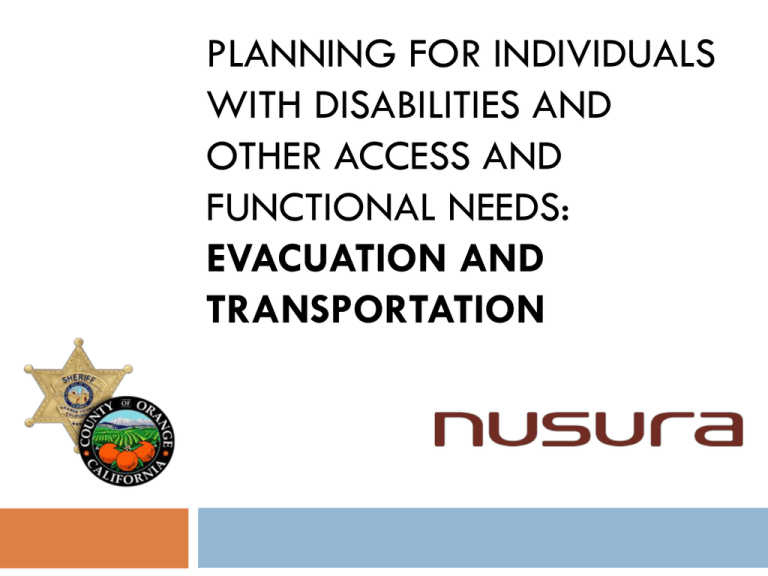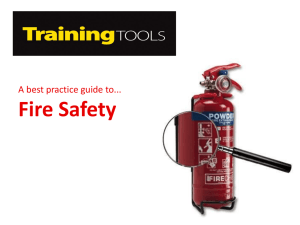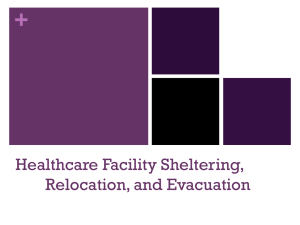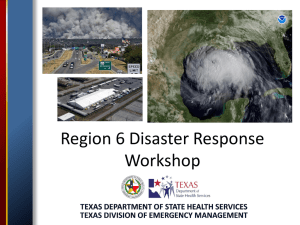Evacuation and Transportation
advertisement

PLANNING FOR INDIVIDUALS WITH DISABILITIES AND OTHER ACCESS AND FUNCTIONAL NEEDS: EVACUATION AND TRANSPORTATION This presentation was created by Nusura, Inc. for the Orange County Sheriff’s Division of Emergency Management Facilitator Introductions June Kailes Gary Gleason Andy Neiman Participant Introductions Name Title Agency/organization Role during an emergency Any burning issues Logistics Safety Electronics Breaks Contact Info Survey feedback Agenda Evacuation basics Evacuation & transportation strategies Coordination & communications Key AFN considerations Evacuation Objectives Expedited movement out of harm’s way Access control Safe re-entry Evacuation and Transportation Planning The goal is to ensure the evacuation needs of the whole community, including those with AFN, are planned for. AFN evacuation planning must be based on an existing community evacuation plan or be a part of a larger, community evacuation planning effort. Transportation-related Vulnerability People who do not drive or do not have access to a personal vehicle for the purposes of evacuation, reentry, and recovery. When considering transportation-vulnerability, remember that some people who do not have transportation-related vulnerability in normal times may have them in a disaster. The vast majority of transportation-related vulnerability is associated with evacuation, and planning for re-entry and recovery should also be considered. Notice vs. No Notice Events Notice Intact infrastructure including roads, communications, and power Staged/progressive evacuation Service continuity Excess self-evacuation of non-required individuals No-notice Damaged infrastructure and assets Situational awareness difficult Population needs less known May be complicated by additional requirements such as decontamination Evacuation Strategies Support self-evacuation Provide resources and support that make self-evacuation or evacuation with friends or family possible. Reduces the burden and costs of facilitated evacuation. Evacuation Strategies, continued Two primary transportation-related evacuation strategies: Accessible transit including, but not limited to, transit vehicles that are lift-equipped, suitable for transporting those on oxygen, etc. Used primarily to help those with mobility-related functional needs, and features vehicles that are lift-equipped, suitable for transporting those on oxygen, etc. Access Used to mass transit for the purposes of evacuation. primarily to help those with transportation-related access challenges such as no access to a personal vehicle or lacking the financial means to evacuate. Non-evacuation Related Transportation Strategies Non-evacuation support strategies to consider: Buses which bring people to recovery centers Subsidizing public transit fees Reentry busing Providing transportation to obtain personal preparedness supplies Evacuation-related Challenges Loss/Separation from adaptive equipment Loss of power Loss/disconnection from service providers First-time customers Lacking resources to evacuate self Personal Preparedness Emphasize and support personal preparedness as part of all planning strategies. Personal preparedness provision for people with access and functional needs to consider include: support networks adaptive equipment and batteries service animals and their provisions rendezvous locations and components accessible transportation medications and medical supplies food and water important legal documents Planning Collaboration Collaborate with partners already working in transportation and evacuation Accessible transit agencies Paratransit systems Dial-a-Ride Mass transit systems Airport shuttle providers School transit systems AFN Planning Elements Mutual Aid/MOUs/Contracted Support Evacuation Intelligence: Needs & Resources Resource Coordination Communication Mutual Aid/MOUs/Contracts Asset management Cost sharing agreement/reimbursement Liability Evacuation Intelligence: Need Where are the transportation-vulnerable populations and what type of assistance will they require? Use existing hazard vulnerability assessments, census data, etc. Evacuation Intelligence: Resources What transit and transportation resources are available? Pre-disaster surveys of resources Type by passenger capacity, fuel type, space for durable medical equipment, owner, and special considerations regarding disaster commitment Post-disaster Plans survey of resources should include procedures for identifying and reporting in on the status of resources (what is damaged, what is available, etc.) Resource Coordination Disasters result in scarce resources Resource distribution and asset allocation must be prioritized and prioritization process documented AFN coordinator in the EOC Communication With transit service providers With individuals with disabilities and other AFN With disability and AFN service and advocacy organizations Include back-up and non-traditional communication strategies A note on registries Registries have limited utility and, often, lots of problems including: Many don’t register Many are afraid to self-identify with a particular limitation Some see registry participation as commitment from community to provide services Instead seek population statistics and other registry type information from agencies and organizations who serve individuals with access and functional needs Collaborate with these agencies to develop process by which they will contact and/or connect individuals requiring assistance with responders during an emergency Evacuation-Transportation Considerations Medical triage Non-ambulatory space Personal care attendants Distance to boarding location Accessible stops, routes to stops (curb cuts) Accessibility by service animals Aisle and doorway widths Space for personal property Accessibility by service animals Time on/in vehicle Key AFN-related Evacuation Plan Elements An inventory of assets by type Clearly defined evacuation thresholds and protocols Language detailing prioritization procedures Procedures for scheduling emergency trips Consideration fare waivers Procedures for communicating evacuation-related information to people with AFN Questions? Discussion Question 1 A successful evacuation often depends on availability of vehicles. A number of interviewees reported a concern about not knowing how many accessible vehicles are available, how accessible they really are, if they are committed to more than one function, etc. Please discuss these issues and planning strategies to solve them. Discussion Question 2 What evacuation/transportation concerns do you have? What ideas and solutions does the group have? Thank You! Please complete the course feedback form before you leave



